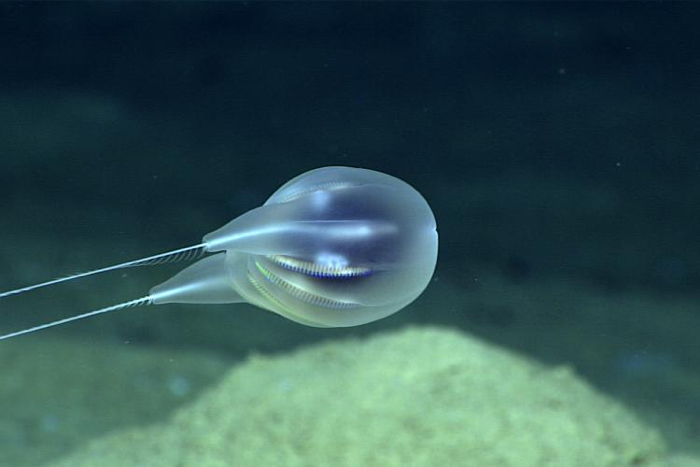Scientists with the National Oceanic and Atmospheric Administration (NOAA) have discovered and identified a new gelatinous species of ctenophor deep in the sea. As reported by Science Alert, this discovery was the first of its kind as this new creature was found using only high-definition video footage captured at the bottom of the ocean. [caption id="" align="alignnone" width="700"]
 Duobrachium sparksae. (NOAA)[/caption] The Duobrachium sparksae was found by the remotely operated vehicle (ROV) Deep Discoverer during a dive off the coast of Puerto Rico. It was first seen in 2015, but the team wanted to ensure this was a new species. This creature's body is less than a millimeter long, but these cameras allow for a high-level of detail that was previously not possible. "We don't have the same microscopes as we would in a lab, but the video can give us enough information to understand the morphology in detail, such as the location of their reproductive parts and other aspects," explains NOAA marine biologist Allen Collins. The D. Sparksae's features a bulbous, balloon-like body with two prominent tentacle arms, and three different individuals were filmed at depths of around 2,900 meters or 2.5 miles down. [widget path="global/article/imagegallery" parameters="albumSlug=the-25-best-sci-fi-movies&captions=true"] "It was a beautiful and unique organism," says oceanographer Mike Ford. "It moved like a hot air balloon attached to the seafloor on two lines, maintaining a specific altitude above the seafloor. Whether it's attached to the seabed, we're not sure. We did not observe direct attachment during the dive, but it seems like the organism touches the seafloor." Ctenophores are also known by the name comb jellies, and have also been referred to as sea gooseberries, sea walnuts, and Venus's girdles. While they may resemble jellyfish, they are not too closely related, and Ctenophores tend to be carnivorous and "subsist on small arthropods and various kinds of larvae." Furthermore, since they live so deep in the ocean, they are "even worse than jellyfish" when it comes to bringing them up to sea level to research. [poilib element="accentDivider"] Have a tip for us? Want to discuss a possible story? Please send an email to [email protected]. Adam Bankhurst is a news writer for IGN. You can follow him on Twitter @AdamBankhurst and on Twitch.
Duobrachium sparksae. (NOAA)[/caption] The Duobrachium sparksae was found by the remotely operated vehicle (ROV) Deep Discoverer during a dive off the coast of Puerto Rico. It was first seen in 2015, but the team wanted to ensure this was a new species. This creature's body is less than a millimeter long, but these cameras allow for a high-level of detail that was previously not possible. "We don't have the same microscopes as we would in a lab, but the video can give us enough information to understand the morphology in detail, such as the location of their reproductive parts and other aspects," explains NOAA marine biologist Allen Collins. The D. Sparksae's features a bulbous, balloon-like body with two prominent tentacle arms, and three different individuals were filmed at depths of around 2,900 meters or 2.5 miles down. [widget path="global/article/imagegallery" parameters="albumSlug=the-25-best-sci-fi-movies&captions=true"] "It was a beautiful and unique organism," says oceanographer Mike Ford. "It moved like a hot air balloon attached to the seafloor on two lines, maintaining a specific altitude above the seafloor. Whether it's attached to the seabed, we're not sure. We did not observe direct attachment during the dive, but it seems like the organism touches the seafloor." Ctenophores are also known by the name comb jellies, and have also been referred to as sea gooseberries, sea walnuts, and Venus's girdles. While they may resemble jellyfish, they are not too closely related, and Ctenophores tend to be carnivorous and "subsist on small arthropods and various kinds of larvae." Furthermore, since they live so deep in the ocean, they are "even worse than jellyfish" when it comes to bringing them up to sea level to research. [poilib element="accentDivider"] Have a tip for us? Want to discuss a possible story? Please send an email to [email protected]. Adam Bankhurst is a news writer for IGN. You can follow him on Twitter @AdamBankhurst and on Twitch.
Continue reading...

Continue reading...
